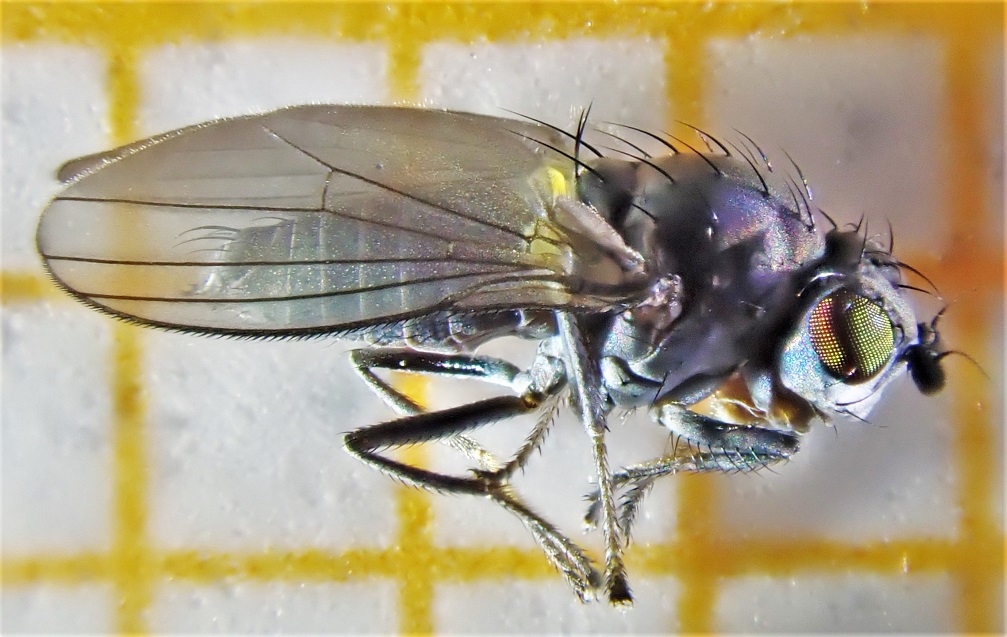Diptera.info :: Identification queries :: Diptera (adults)
Who is here? 1 guest(s)
|
Canacidae, Polynesia => Nocticanace peculiaris
|
|
| basti_st |
Posted on 10-03-2022 08:15
|
|
Member Location: PF & NZ Posts: 35 Joined: 30.06.21 |
I collected this fly at the beach today and identified it as Ephydridae, probably genus Paralimna, but I am not entirely certain about my identification, so I would be happy about any input to this fly. Thanks!
basti_st attached the following image:  [258.51Kb] Edited by basti_st on 13-03-2022 07:29 |
|
|
|
| basti_st |
Posted on 10-03-2022 08:32
|
|
Member Location: PF & NZ Posts: 35 Joined: 30.06.21 |
Lateral
basti_st attached the following image:  [232.53Kb] |
|
|
|
| John Carr |
Posted on 10-03-2022 11:07
|
|
Member Location: Massachusetts, USA Posts: 10172 Joined: 22.10.10 |
This is not Paralimna, which has bristles on the mid tibia, hairs on the parafacial, and a haired arista. In the Ephydridae lateroclinate fronto-orbital setae are found in subfamily Ephydrinae, but the face of your fly is not swollen and haired like typical Ephydrinae. The course of the subcosta makes me think of Agromyzinae. Species of that subfamily can be dark metallic with contrasting yellow halteres. |
| Tony Irwin |
Posted on 10-03-2022 11:20
|
|
Member Location: Norwich, England Posts: 7232 Joined: 19.11.04 |
The face and ovipositor suggest Canacidae to me.
Tony ---------- Tony Irwin |
|
|
|
| basti_st |
Posted on 10-03-2022 19:49
|
|
Member Location: PF & NZ Posts: 35 Joined: 30.06.21 |
Very helpful, thanks! Dasyrhicnoessa (subfamily Tethininae) and Nocticanace (subfamily Canacinae) are both known from Eastern Polynesia. Might this fly be either of these two genera?
Edited by basti_st on 10-03-2022 20:10 |
|
|
|
| Tony Irwin |
Posted on 10-03-2022 20:07
|
|
Member Location: Norwich, England Posts: 7232 Joined: 19.11.04 |
I would say Nocticanace, or something very close.
Edited by Tony Irwin on 10-03-2022 21:40 Tony ---------- Tony Irwin |
|
|
|
| basti_st |
Posted on 10-03-2022 20:12
|
|
Member Location: PF & NZ Posts: 35 Joined: 30.06.21 |
Description and genitalia illustrations of Nocticanace peculiaris in 'Wirth 1951 a revision of the dipterous family Canacidae' would fit to the collected species, incl. pale yellow halteres (mentioned by John above). This species is also known from Eastern Polynesia, but not recorded in the Society Islands Edited by basti_st on 10-03-2022 20:13 |
|
|
|
| Tony Irwin |
Posted on 10-03-2022 21:49
|
|
Member Location: Norwich, England Posts: 7232 Joined: 19.11.04 |
Yes, that looks like a good match.
Tony ---------- Tony Irwin |
|
|
|
| Jump to Forum: |
















